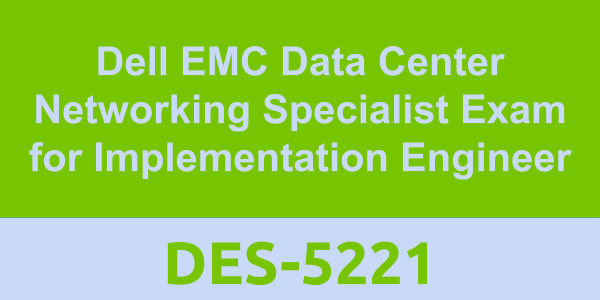This exam is a qualifying exam for the Specialist – Implementation Engineer, Data Center Networking track.
This exam focuses on concepts related to the Data Center environment and Dell EMC Networking’s S-Series and Z-Series products. Focus is on Dell EMC Networking SmartFabric OS10-based protocols and features.
Dell Technologies provides free practice tests to assess your knowledge in preparation for the exam. Practice tests allow you to become familiar with the topics and question types you will find on the proctored exam. Your results on a practice test offer one indication of how prepared you are for the proctored exam and can highlight topics on which you need to study and train further. A passing score on the practice test does not guarantee a passing score on the certification exam.
Dell EMC Data Center Networking Implementation Engineer Exam Summary:
| Exam Name | Dell EMC Certified Specialist - Implementation Engineer - Data Center Networking |
| Exam Code | DES-5221 |
| Exam Price | $230 (USD) |
| Duration | 90 mins |
| Number of Questions | 60 |
| Passing Score | 63% |
| Books / Training | Dell EMC Networking - Data Center Configuration and Administration (ES102NET00232) Dell EMC Networking - Data Center Configuration and Administration (DESPR-826-8015 LATAM) |
| Sample Questions | Dell EMC Data Center Networking Implementation Engineer Sample Questions |
| Practice Exam | Dell EMC DES-5221 Certification Practice Exam |
Dell EMC DES-5221 Exam Syllabus Topics:
| Topic | Details | Weights |
| Networks - The Basics | - Identify common data center topologies, protocols, and topologies; describe the Dell EMC data center switch portfolio - Basic switch configuration: Identify the normal boot process of a S and Z-Series switch running OS 10. List the first-time switch setup requirements. Perform the steps for upgrading switch firmware in OS 10. - Access Control Lists: Explain the purpose of access control; apply appropriate commands to deny or permit IP connectivity; complete the required configuration to permit host access control; determine why particular computers are being blocked from accessing a server - AAA Security: Explain the purpose of AAA security; describe AAA process, core components and their function; configure local and RADIUS authentication - Dynamic Host Configuration Protocol: DHCP’s basic operation; Explain the role of the DHCP Relay; configure DHCP in OS10; identify the options to secure DHCP from attacks |
19.6% |
| Layer-2 Technologies and Protocols | - Virtual Lans - Identify the characteristics of a VLAN; explain the differences between tagged and untagged frames; configure VLAN trunking; configure VLAN Port membership; verify trunking and Port Membership; troubleshoot VLANs - Spanning-tree Protocol - Identify the operations and use cases for STP; Configure and validate RSTP/MSTP/RSTP-PV; Manipulate spanning tree root bridge and port cost configurations - Link Aggregation Groups - Identify the operations and use cases for LAGs; configure, verify, and trouble shoot static LAGs; configure, verify, and troubleshoot dynamic LAGs - Discovery Protocols - Describe the characteristics of discovery protocols; describe uses cases for using discovery protocols; explain how to configure and validate. Configure discovery protocols; interpret LLDP outputs |
20.1% |
| Discovery Protocols - Describe the characteristics of discovery protocols; describe uses cases for using discovery protocols; explain how to configure and validate. Configure discovery protocols; interpret LLDP outputs | - Basic Routing - Configure IPv4 on an interface; identify when to utilize a gateway as a last resort; configure and modify static routes; test inter-VLAN routing - Open Shortest Path First - describe OSPF operation, and core components; configure and validate OSPF using; interpret OSPF show commands; describe the operations and use cases for ECMP; test inter-VLAN routing - Border Gateway Protocol - Explain operations of BGP; - identify design best practices when configuring BGP in a leaf/spine environment; configure and validate BGP; Describe the operations and use cases for ECMP; configure and validate ECMP - Policy-Based Routing - Describe the basic operation of PBR; identify PBR use cases; configure and validate PBR |
30.7% |
| Data Center Technologies and Protocols | - Virtual Link Trunking - Describe the components that makeup a VLT configuration; Configure and validate VLTs; troubleshoot basic VLT configuration issues - Virtual Router Redundancy Protocol - describe the basic operation of VRRP; identify the components of VRRP; describe VRRP Priorities; compare Pre-empt and no Pre-empt; configure VRRP on switches configured for VLT - Uplink Failure Detection - describe the components and operation of UFD; identify the differences between Active/Active and Active/Standby; configure and verify UFD - Virtual Routing and Forwarding - describe the operations and use cases for (VRF); configure and validate VRF - Quality of Service - Describe the basic operation of QoS; Describe how QoS identifies and marks traffic; identify the characteristics of QoS; identify QoS protocols and their uses; configure QoS - Multicast - Explain in depth the concepts relating to IP Multicast technology; compare IGMP and PIM use cases; identify the steps required to configure multicasting into an existing multicast environment |
29.6% |





0 comments:
Post a Comment